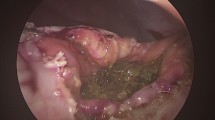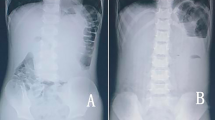Abstract
Trichobezoars are difficult to remove endoscopically, often cause nausea and vomiting, and can result in small-bowel obstruction. A patient with a trichobezoar presented to our clinic with symptoms of partial small-bowel obstruction. Multiple attempts at flexible endoscopic removal were unsuccessful. Two large-diameter percutaneous gastrostomies with an inflatable balloon and distal foam-rubber stent to assure intragastric positioning were introduced under general anesthesia. Visualization was provided by a 0° panavision laparoscope placed through one of the gastrostomies. The bezoar was removed through the second gastrostomy using standard laparoscopic instruments. The patient made an uneventful recovery. This is the first reported case of percutaneous removal of a trichobezoar. We conclude large-diameter gastrostomies may serve as a port of access for numerous other intraluminal procedures.
Similar content being viewed by others
References
Andrus CH, Ponsky JL (1988) Bezoars: classification, pathophysiology, and treatment. Am J Gastroenterol 83: 476–478
Baudamant WW (1780) Description de deux masses de cheveux trouvees dans l'estomac et les intestines d'un jeune garcon age de seize ans. Hist Soc R Med 2: 262–281
Calabuig R, Navarro S, Carrio I (1989) Gastric emptying and bezoars. Am J Surg 157: 287–290
Debakey M, Oschner A (1938 and 1939) Bezoars and concretions. Surgery 4: 934–963 and 5: 132–160
Diettrick NA, Frederick CG (1985) Postgastrectomy phytobezoars—endoscopic diagnosis and treatment. Arch Surg 120: 432–435
Madsen R, Skibba RM, Galvan A, Striplin C, Scott P (1978) Gastric bezoars: a technique of endoscopic removal. Dig Dis Sci 23: 717–719
McKechnie JC (1972) Gastroscopic removal of phytobezoar. Gastroenterology 62: 1047–1051
Rees M (1984) Intussusception caused by multiple trichobezoars: a surgical trap for the unwary. Br J Surg 71: 721
Rosen P, Gilat T (1975) Enzymatic softening and endoscopic destruction of a phytobezoar in an unoperated stomach. Am J Gastroenterol 64: 397–399
Schonborn B (1883) Eine durch gastrotomie entfernte haar geschwulst aus dem magen eines jungen madchens. Arch Klin Chir 29: 609–614
Swain PC, Kakirkamanathan SS, Gong F, Chai Lai K, Ratani RS, Brown GJ, Mills TN (1994) Knot tying at flexible endoscopy. Gastroinest 40: 722–729
Thompson H, Gregory DH (1973) Mucus gastric bezoar. Gastrointest Endosc 20: 69–70
Vaughan ED Jr, Sawyers JL, Scott HW (1968) The Rapunzel syndrome: an unusual complication of intestinal bezoar. Surgery 63: 339–343
Walker-Renard P (1993) Update on the medicinal management of phytobezoars. Am J Gastroenterol 88: 1663–1666
Author information
Authors and Affiliations
Rights and permissions
About this article
Cite this article
Filipi, C.J., Perdikis, G., Hinder, R.A. et al. An intraluminal surgical approach to the management of gastric bezoars. Surg Endosc 9, 831–834 (1995). https://doi.org/10.1007/BF00190094
Received:
Accepted:
Issue Date:
DOI: https://doi.org/10.1007/BF00190094




